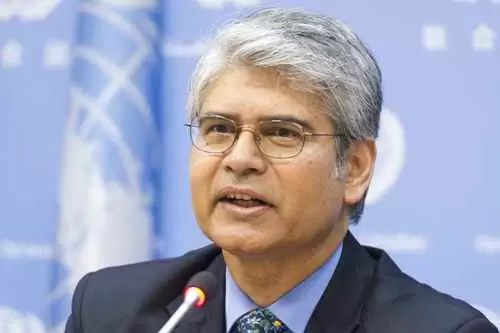A volume of nuggets of historical facts and rare photographs showing India’s role in UN
02-November-2015
Vol 6 | Issue 44
When the UN was but a glimmer in the eyes of Allied statesmen in 1942, pre-independence India's involvement in the idea of a world body began with a representative of India, G.S. Bajpai, signing the "Declaration by the United Nations" in Washington while World War II rained death and destruction around the globe.
The arm-in-arm journey of India and the international organisation has been chronicled by India's Permanent Representative Asoke Kumar Mukerjee in "India and The United Nations -- A Photo Journey: 1945-2015," a volume of nuggets of historical facts and rare photographs culled from a trove of over 800,000.
 |
|
India's Permanent Representative to the United Nations, Asoke Kumar Mukerji, has chronicled India's role at the UN in his book, "India and the United Nations -- a Photo Journey: 1945-2015" (Photo: UN Photo/ IANS)
|
When the UN was born in 1945, India was still a colony. But with its independence looming on the horizon and in a premonition of its global importance it became a full-fledged founding member of the organisation.
It was represented on UN flagpoles by a blue flag with the Union Jack and the Great Seal with the Star of India, which was replaced by the Indian Tricolour when India won its freedom in 1947.
Enshrining the promotion of human rights was India's significant contribution to the framing of the UN Charter, Mukerjee writes.
The Charter was signed in San Francisco by Ramaswami Mudaliar, the leader of the Indian delegation to the UN, and V.T. Krishnamachari, who represented the princely states. The Charter came into force on Oct 24, 1945 creating the global body, and that day is celebrated as UN Day every year.
The 374-page book, first presented by Prime Minister Narendra Modi to Secretary General Ban Ki-moon last month, received wider circulation at this year's UN Day celebration. Published by India's UN mission, it comes at a crucial time as momentum gains for Security Council reforms and it reinforces India's credentials for a permanent seat on it through its record of involvement with and service to the UN.
"This book seeks to illustrate how India and the United Nations have influenced each other," Mukerjee writes in his introduction. "India's evolution as the world's largest parliamentary democracy, and India's experience of transforming itself into one of world's largest emerging democracies has been pivotal."
Mukerjee traces the pioneering role of India at the nascent UN with New Delhi becoming one of the framers of the convention against genocide in a world reeling from its horrors. It was adopted by the first General Assembly session in 1946 London.
At the same session Mudaliar was elected chairman of the Economic and Social Council.
In a historic first, Vijaya Lakshmi Pandit, the sister of Jawaharlal Nehru, led the Indian delegation to that session -- the only woman to do so. In 1953, she was elected president of the General Assembly, the first woman to hold the position.
Hansa Mehta became a member of the Sub-Commission on the Status of Women in 1946. Her mark on history was ensuring that women were recognised in the Universal Declaration of Human Right by having the phrase, "all men are created equal" changed to "all human beings are created equal," Mukerjee writes.
In an instance of early support for China, India, then a member of the Security Council, voted to replace Taiwan with China as a permanent member.
As Communist forces invaded South Korea in 1950, the UN mobilised a military force against them. "India decided not to get involved militarily but contributed a military unit, the 60th Parachute Field Ambulance," Mukerjee writes. Its members earned the title of "Maroon Angels" by serving not only the military forces, but also civilians and the North Korean prisoners of war. The humanitarian tradition continues in other hotspots around the world.
India's long association with armed peace-keeping operations began in 1956 when the UN created the first such mission, the UN Emergency Force (UNEF), in the Middle East after the hostilities of the Suez Crisis.
Since then India has participated in 48 of the 69 UN peace-keeping missions. Having sent over 185,000 personnel, it is the largest overall troop contributor to UN peace operations. A special section of the book, with an introduction by Lt. Gen. Satish Nambiar, deals with India's contributions to the UN's military-related operations.
Mukerjee succinctly explains key Indian positions ranging from the Kashmir issue at the UN to New Delhi's refusal to sign the nuclear non-proliferation treaty.
Every major international issue at the UN, from trade and development to fighting Ebola and terrorism, find a place in the definitive chronology.
Mukerjee notes that India's involvement predates the UN by decades when it became a founding member of the International Labor Organisation (ILO) associated with the ill-fated League of Nations. The ILO became a UN agency in 1946.
And from there the history goes all the way to the celebration of the First International Day of Yoga at the UN this year and the adoption of the new sustainable development goals. - IANS














